History of the DNT
The Deutsches Nationaltheater Weimar is one of the oldest theatres in germany with a long tradition and a history dating back to the 18th century when the most famous german author of the classical period – Johann Wolfgang von Goethe – directed the theatre. Today the Deutsches Nationaltheater offers a broad repertoire of classical and modern opera and theatre productions as well as concerts in four very different venues: Großes Haus, Studiobühne, E-Werk and Weimarhalle.
Goethe, Schiller, Bach, Hummel, Liszt, Strauss – only few german theatres can look back onto such a rich background of famous artists like the Deutsches Nationaltheater Weimar. Its history reaching from 18th to 21st century, the theatre not only needs to reflect the tensions between classic and modern times but also between humanism and most recent german historical developments. As a point of artistic reflexion and cristallisation the theatre and its artistic and political development stood between avant-garde and the maintenance of tradition, between ideals and their betrayal for propaganda or the need to economise.
Next to a strong ensemble of singers and actors another important branche of the Deutsches Nationaltheater Weimar is the Staatskapelle – one of the oldest orchestras in germany and the only one of its size in thuringia.
With up to 600 performances and concerts per year, Staatskapelle and DNT have a major part in forming the cultural calendar of the city of Weimar. A continuing contemporary discussion of the classical repertoire is an important part of the theatres program alongside world premieres of contemporary pieces and operas or the development of plays by young writers. With a rich and diverse range of programs for kids and teenagers the theatre- and concert paedagogical department of the DNT offers a variety of possibilities for the young generation to develop an artistic and socio-political awareness and understanding of the past and future.
The neoclassical theatre building with a modern interior was built 1906/07 at the location of the former court theatre. 1945 the building was destroyed shortly before the end of the war and was rebuilt 1947-1948 as the first german theatre. The auditorium where the weimar republic was proclaimed in 1919 received its actual optic in the 1970ies.
The former electricity station, now called E-Werk and under monument conservation, has been an alternative venue for unconventional projects of the DNT since 2000. It has since developed to be an attractive meeting point for the young generation, where mostly contemporary theatre works are performed in variable play-rooms.
Staatskapelle Weimar
The Staatskapelle Weimar, founded in 1491, is one of the oldest, most illustrious orchestras in the world and is closely associated to some of the world’s best known musicians and works. In 1756, Duchess Anna Amalia made the orchestra the primary musical institution of ‘Classical Weimar’. Thanks to the influence of Grand Duchess Maria Pavlovna, a number of prominent musical figures of the 19th century, including Mozart’s former student Johann Nepomuk Hummel, were appointed to lead the orchestra. The famous musician, Franz Liszt, served as Hofkapellmeister from 1848 to 1858 and produced the world premieres of numerous contemporary pieces, such as Wagner’s “Lohengrin” (1850), which he helped make an international success. Richard Strauss served as second Kapellmeister from 1889 to 1894 and produced the world premieres of his own “Guntram” and Humperdinck’s „Hansel and Gretel“. Under his direction, the court orchestra also performed the world premieres of his orchestral works “Don Juan”, “Macbeth” and “Death and Transfiguration”.
The positive progress of the orchestra, renamed the “Weimarische Staatskapelle” in 1919, came to an abrupt end when the National Socialists seized power in 1933. Following the calamitous events of World War II, the conductor Hermann Abendroth re-established the Staatskapelle Weimar to its former grandeur and quality, making it one of Germany’s leading orchestras. Since the 1980s, the conductors Peter Gülke, Oleg Caetani and Hans-Peter Frank as well as the present honorary conductor George Alexander Albrecht, who headed the orchestra from 1996 to 2002, have left a lasting mark. As General Music Director and Principal Conductor of the Deutsches Nationaltheater and Staatskapelle Weimar, Albrecht was succeeded by Jac van Steen (2002 to 2005), Carl St. Clair (2005 to 2009) and Stefan Solyom (2009 to 2016).
Both in its extensive concert activities and opera productions at the Deutsches Nationaltheater Weimar, the Staatskapelle has worked to cultivate its great tradition in combination with innovative aspects. A wide range of CD recordings reflect its impressively diverse repertoire with works by Wolfgang Amadeus Mozart, Franz Liszt, Richard Wagner, Richard Strauss, Wilhelm Furtwängler, and several contemporary composers.
World-class soloists and conductors perform regularly with the Staatskapelle Weimar which is nationally and internationally renowned as a first-class concert orchestra. In past years, the ensemble has made guest appearances in Japan, Israel, Spain, Italy, Austria, Switzerland, Great Britain and most recently in the United States on a monthlong tour as well as at renowned festivals and major concert halls throughout Germany.
At the beginning of the 2016/17 season, the Ukrainian conductor Kirill Karabits took the reigns as General Music Director and Principal Conductor of the Deutsches Nationaltheater and Staatskapelle Weimar – the only A-level orchestra in the state of Thuringia.
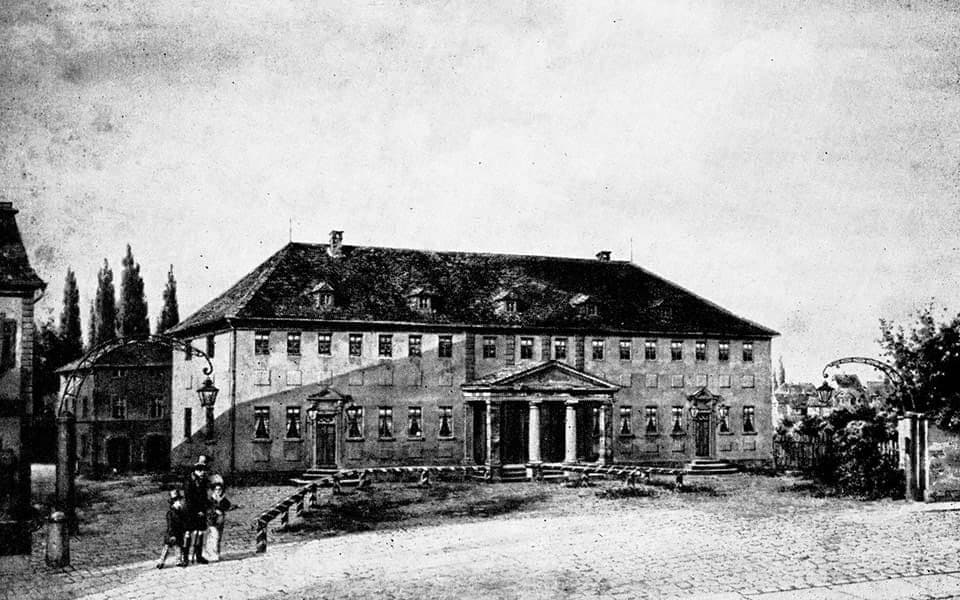
Goethe was entrusted with the direction of the court theatre and he opened it in 1791 with Iffland's play "Die Jäger". Goethe made sure that an acting ensemble could form which corresponded to the requirements of the classical dramas according to his "Regeln für Schauspieler" (1803). The formerly infamous reputation of the art of acting gave way to a high esteem and social recognition of the actors as artistic personalities.
In 1798, at Goethe's instigation, the court theatre was transformed into a representative theatre with galleries, columns and balconies and enlarged to 1,000 seats. From 1799 to 1805, Schiller's year of death, Goethe and Schiller, who had meanwhile moved from Jena to Weimar, worked together on the Weimar stage. Schiller staged his plays himself. The premieres of the three parts of "Wallenstein" (1798/99) established Schiller's fame as a playwright. With the exception of the "Jungfrau von Orleans", all of Schiller's late plays were premiered in Weimar. The monument to Ernst Rietschel, inaugurated in 1857, symbolizes the fruitful joint work of Goethe and Schiller in Weimar and has become the city's landmark. In March 1825 the court theatre burned down, but in September of the same year the gates of a new theatre building opened on the same site.
The era of music: Hummel, Liszt and Strauss in Weimar
Maria Pavlovna, wife of Grand Duke Carl Friedrich von Sachsen-Weimar-Eisenach, had been particularly committed to musical life in Weimar since 1804. After Goethe's resignation, she appointed Johann Nepomuk Hummel, Mozart's pupil and piano virtuoso, who was famous throughout Europe, to Weimar as Kapellmeister, a position he held until his death in 1837. The works of Mozart, Haydn and Beethoven determined his concert program. One of the musical and social highlights of the Weimar Court Theatre under Hummel's direction was a concert by the famous Italian violin virtuoso Nicolo Paganini in 1829.
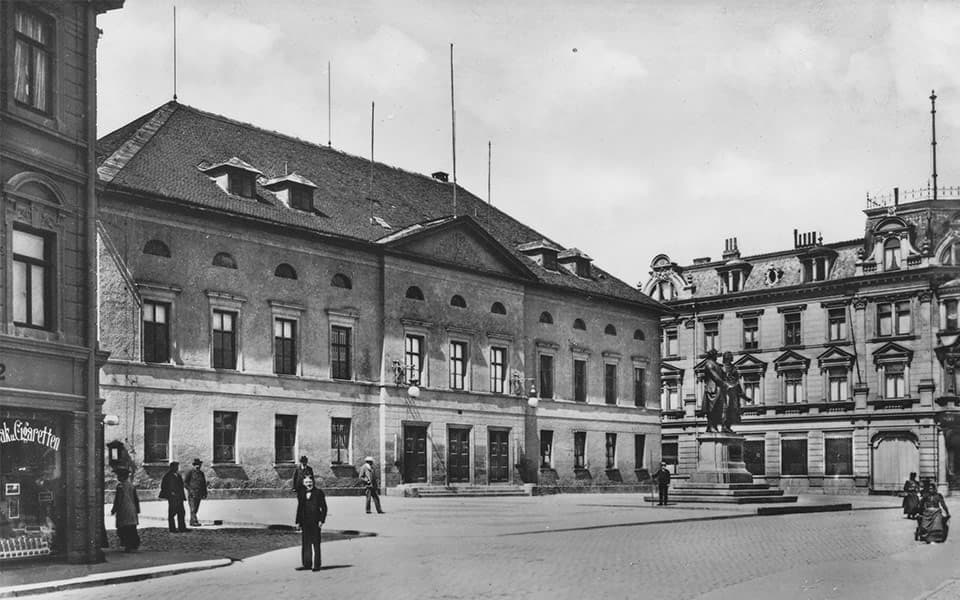
Hummel was a pioneer for the "Silver Age of Music" in Weimar. But it was the work of Franz Liszt that established Weimar's fame as a city of music. In 1842 Liszt became Kapellmeister in extraordinary services. In 1848 he took over the office of court conductor. His intention was to replace the era of literature associated with the names Goethe and Schiller with an era of music. Liszt himself and his esteemed Richard Wagner were to stand for this renewal.
The opera "Lohengrin" by the then sought-after Dresden conductor Richard Wagner was premiered at the Hoftheater in 1850 under the baton of Franz Liszt, one year after the performance of "Tannhäuser" in Weimar. Under the general director Franz von Dingelstedt, who was appointed in 1857, the play in Weimar became nationwide important again. Especially performances of the works of Franz Grillparzer, Johann Nepomuk Nestroy, Karl Gutzkow and Friedrich Hebbel drew attention to Weimar. In 1861 Hebbel's much acclaimed "Nibelungen" trilogy was premiered here.
In 1889 Richard Strauss became Kapellmeister in Weimar. Together with the court orchestra he premiered his tone poems "Don Juan", "Macbeth" and "Death and Transfiguration". His opera "Guntram" was first performed in Weimar in 1894. Strauss also achieved great success in 1893 with the premiere of Humperdinck's fairytale opera "Hänsel und Gretel".
The Failed Dream of the Avant-garde »Mustertheater«
Around 1900 Nietzsche's writing "Die Geburt der Tragödie aus dem Geist der Musik" (1878) became the initial spark for considerations on basic theatre forms. The dream of the Gesamtkunstwerk formed the guiding idea for a "festival play" on stage. Festival projects based on the Bayreuth model were to be the guarantee for a national renewal of theatre. Harry Graf Kessler and Henry van de Velde had plans for a "model theatre" as an avant-garde alternative to court theatre. Conceived as a Weimar Festival, the best German actors were to perform classical and modern plays in the three summer months. The aim was to create a "Bayreuth for dramatic literature" in Weimar. The then director of the court theatre Hippolyt von Vignau thwarted this plan with the support of conservative forces. Since the almost 80-year-old building of the Weimar Court Theatre no longer met the requirements in terms of size, building fabric and technology, architect Max Littmann was commissioned in 1906 to build a new theatre building.
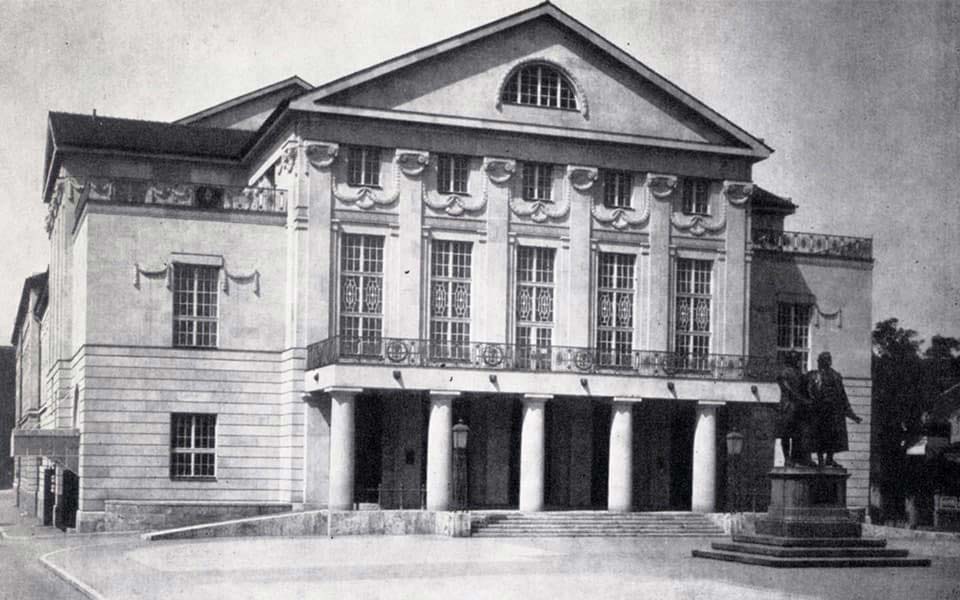
The old building was completely demolished and the foundation of the new building was fortified with over 1,800 wooden pillars on which the building still rests today. The new court theatre had a capacity of 1,080 seats and was one of the most modern of its time. The inauguration was celebrated on 11 January 1908 as a solemn act of state, which was also attended by Emperor Wilhelm II and over 70 directors of other theatres.
The theatre as a political stage
Artistically, the court theatre under the artistic direction of Carl von Schirach (1909-1918), who relied on a classically oriented repertoire, made little mention of itself. Nevertheless, the court theatre became a place of worship for the conservative educated middle classes. With the proclamation of the Republic and the abdication of Emperor Wilhelm II, Carl von Schirach was also deposed. On 1 January 1919, the provisional state government appointed the writer Ernst Hardt as the new artistic director. The court theatre was renamed "Landestheater" and the court chapel was now called "Weimarische Staatskapelle". Already on 19 January, the day of the elections to the constituent National Assembly, Hardt announced the renaming of the theatre, which was to be called "Deutsches Nationaltheater in Weimar" from then on.
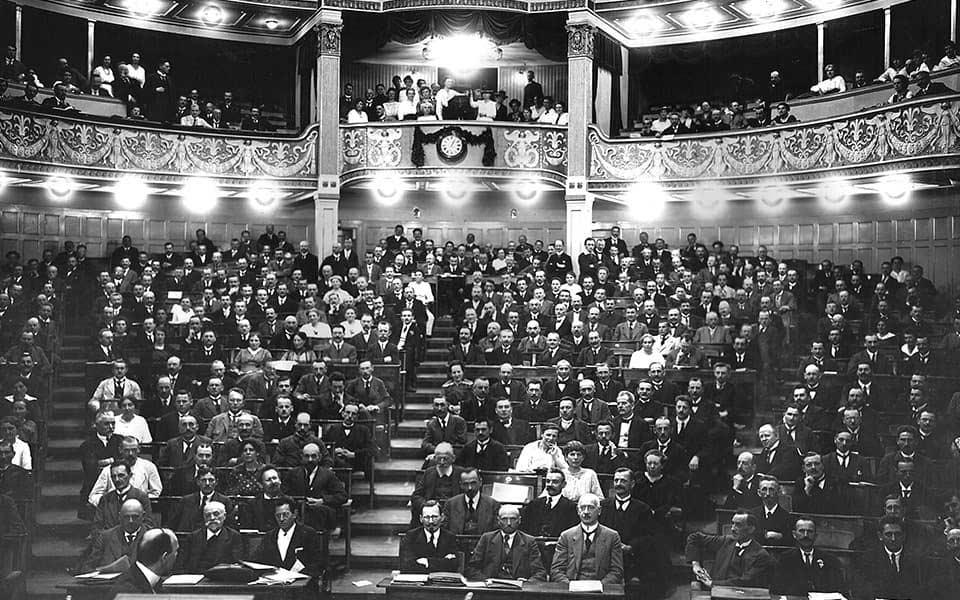
Two days later it was publicly announced that the National Assembly would meet in Weimar from 6 February to 21 August 1919. For this purpose, the auditorium was converted into a plenary hall. On 31 July 1919 the delegates approved the first democratic constitution of Germany in its final form.
The DNT during the NS era
With the support of the conservative state government, the National Socialists had been organizing regular party meetings in Weimar since 1924. In 1926 the first National Party Congress of the NSDAP was held in the theatre after the ban was lifted. The general director Ernst Hardt left the theatre in 1924 after there had been fierce and defamatory protests against his performances from the national side. His successor Franz Ulbrich also tried to continue playing contemporary authors such as Ernst Toller, Carl Sternheim and others despite threats of censorship and demands for "purges" of the Weimar theatre play plan. However, he increasingly compromised with the National Socialists, who from 1930 were involved in the state government and demanded a "Jew-free theatre". In 1933 Ernst Nobbe, an NSDAP member, took over the directorship, followed in 1936 by Hans Severus Ziegler, who had co-initiated the decree "Wider die Negerkultur für deutsches Volkstum".
During the Nazi regime mainly a classical repertoire was played, whereby especially Schiller's drama was put into a National Socialist perspective. Hitler wanted to develop the Weimar Theater into one of the leading stages of the German Reich and supported the DNT annually with private funds.
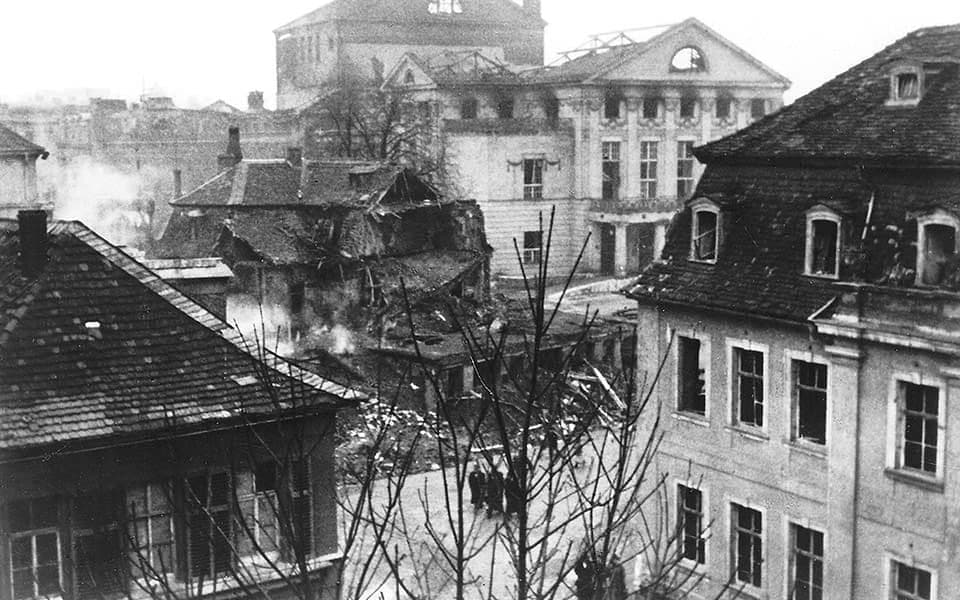
The reconstruction of the auditorium in 1939/40 and the refurbishment of the stage technology consumed a sum of over 800,000 Reichsmark, which Hitler personally procured. The fact that such a sum was raised during the war years illustrates the special significance of the DNT at that time. The theatre also played for the entertainment of the SS members in the casino of the Buchenwald concentration camp. While Franz Lehár's "The Land of Smiles" was performed at the DNT, Fritz Löhner-Beda, the Jewish librettist of this operetta, was imprisoned only a few kilometres away in Buchenwald. His name was not mentioned in the programme.
In autumn 1944 all theatres in Germany were closed. The DNT was rented as a production facility to Siemens & Halske. On February 9, 1945, an American bombing raid destroyed the theater except for the facade and the foyer. The Weimar Theatre was, however, the first German theatre to be rebuilt after the war and reopened in 1948 with Goethe's "Faust".
In 1949, on the occasion of the award of the Goethe Prize in the DNT, Thomas Mann spoke of the hope that "a new humanism may emerge from the hardships of this transitional period".
From Socialist Social Theatre to the Present Day
During the GDR era, the Weimar theatre and especially the play "were to bear witness to the socialist social practice as the spiritual yardstick of human development". In the 1950s, under the general directorship of Karl Kayser (1950-1958), who was also a member of the Central Committee, Soviet revolutionary dramas were the main feature of the programme. Visitor groups from all parts of Thuringia were brought to the theatre by bus and train - as was customary even before the war. On Schiller's 200th birthday, the "Schiller Festival of German Youth" was held at the DNT - which was then continued annually as the "FDJ Theatre Days". However, even then there was harsh criticism of the agitational and bold interpretation of the classics, as forced by Kayser to implement the resolutions of the SED. Under the directors Otto Lang (1958-1973) and Gert Beinemann (1973-1987) the programme included works by GDR composers and authors (e.g. Ottmar Gerster, Johannes R. Becher, Bertolt Brecht, Volker Braun, Peter Hacks), but also works by Max Frisch ("Biedermann und die Brandstifter", 1965) and Friedrich Dürrenmatt ("Besuch der alten Dame", 1978). Throughout the GDR period, the DNT remained a venue for important classical productions. Between 1973 and 1975 the theatre building was extensively renovated and rebuilt. The DNT's current form, especially that of the auditorium, dates from this period. The DNT was one of the most technically modern theatres in the country at the time.

With Harry Kupfer (1966-1973) and his successor Erhard Warneke (1973-1999), the DNT has two extraordinarily successful opera directors, Harry Kupfer (1966-1973) and Erhard Warneke (1973-1999), who have earned international recognition especially for their commitment to contemporary music theatre. In the field of drama, the overall staging of both parts of "Faust" by the director Fritz Bennewitz, who has been working at the theatre since 1960, is particularly noteworthy. His Brecht productions also attracted international attention.
Fritz Wendrich (1987-1994) was succeeded by Günther Beelitz (1994-2000). Under his general directorhip, classical ballet was replaced by contemporary dance theatre (chief choreographers: Joachim Schlömer, later Ismael Ivo). From 2000 to 2012 Stephan Märki was General Director of the DNT. A planned merger with Theater Erfurt, which would have meant the abolition of music theatre, was prevented in 2002 with great support from the population of Weimar. With the transition to a non-profit limited company and the structural reforms carried out under the name "Weimarer Modell", it was possible to preserve the autonomy of the traditional theatre as a three-division theatre. With the decision to make DNT and Staatskapelle Weimar the State Theatre of Thuringia on 1 January 2008, a further important step was taken to secure the future of the company. The DNT and the Staatskapelle Weimar offer a broad repertoire of classical and contemporary works in the fields of opera, drama and concert. Invitations to major theatre festivals (including the Theatertreffen Berlin), nominations and awards, important world premieres, outstanding large-scale projects such as the production of the complete "Ring des Nibelungen" (2006-2008) and national and international co-productions bear witness to the artistic position of the Staatskapelle Weimar. At the beginning of the 2013/14 season, Hasko Weber took over as General Director of the DNT. Since the end of 2013, the Kunstfest Weimar has also belonged to the DNT. From 2014 to 2018 this took place under the artistic direction of Christian Holtzhauer. The current artistic direction, beginning with the Kunstfest Weimar 2019, is with Rolf C. Hemke.
Staatskapelle Weimar
The Staatskapelle Weimar is one of the most traditional orchestras in the world and one of the oldest orchestras in Germany. Elector Friedrich III founded a court orchestra in 1491, whose continued existence over the centuries was always subject to the whims and inclinations of the respective ruler. The orchestra was dissolved several times, but was also refounded again and again, and over time it was adapted to the demands of music, opera and the will to represent and constantly expanded. It was not until 1602, when Duke Johann III ordered his then 11 musicians to the new main residence in Weimar, that the orchestra finally found its permanent location after an eventful wandering life from residence to residence.
From the 19th century onwards, important personalities, among them the Mozart pupil Johann Nepomuk Hummel, led the orchestra under the hereditary grand-duchess Maria Pavlovna. Franz Liszt's engagement as Hofkapellmeister (1848-1858), who initiated premieres of numerous contemporary works in Weimar and staged Wagner's "Tannhäuser" in 1849, also testifies to the great role of the Hofkapelle in and for Weimar. Wagner then entrusted Liszt with the premiere of his "Lohengrin", which was first performed in Weimar in 1850. A leading conductor and composer met Richard Strauss, who was the second Kapellmeister in Weimar from 1889 to 1894, soon afterwards, and helped the orchestra to a considerable qualitative upswing. In Weimar Strauss conducted the world premiere of his first opera "Guntram" (1894) as well as the world premiere of Humperdinck's "Hänsel und Gretel" (1893). In addition, his orchestral works "Don Juan", "Macbeth" and "Death and Transfiguration" were first performed by the Weimar Court Orchestra. In 1919 the orchestra was appointed the "Weimar State Orchestra".
The seizure of power by the National Socialists temporarily put an end to the positive development of the orchestra, which was renamed "Weimarische Staatskapelle" in 1919. Ernst Praetorius, who had been General Music Director since 1924, experienced fierce hostility for his commitment to new music and was publicly called upon to part with his Jewish wife. In 1933 the theatre management finally dissolved his contract in Weimar and he emigrated to Ankara where he took over the direction of the symphony orchestra there. In the following years numerous Jewish musicians and soloists were dismissed, killed in concentration camps or committed suicide.
Under the general music director and chief conductor Hermann Abendroth a newly formed Staatskapelle developed within a short time after 1945, which quickly regained considerable size and quality and grew into one of the leading German orchestras. From the 1980s onwards, the conductors Peter Gülke, Oleg Caetani and Hans-Peter Frank had a formative influence on the orchestra, which since 1988 has borne the name "Staatskapelle Weimar" and after 1990 was expanded to almost 100 musicians. From 1996 to 2002, the current honorary conductor George Alexander Albrecht was chief conductor and general music director in Weimar. He was succeeded in 2002 by the Dutchman Jac van Steen, in 2005 by the American Carl St. Clair and in 2009 by the Swede Stefan Solyom. Today, the Staatskapelle Weimar combines the conscious cultivation of its great traditions with innovative aspects and guarantees the continuation of the great late romantic opera tradition at the DNT Weimar at the highest level. Numerous CD recordings reflect the diverse, constantly expanding repertoire from Mozart to Liszt, Wagner, Strauss and Furtwängler right up to the modern age. Internationally renowned soloists and conductors are regular guests of the orchestra, which is much in demand far beyond the classical city. In recent years, tours and guest concerts have taken the orchestra to Japan, Israel, Spain, Italy, Great Britain, Austria, Switzerland and most recently for four weeks to the USA, as well as to the major concert halls in Germany and to major festivals.
Since the beginning of the 2016/17 season, the Ukrainian conductor Kirill Karabits has headed the only A orchestra in the state of Thuringia as General Music Director and Chief Conductor.
Theater und Musik in Weimar 1754 – 1990
Tauchen Sie unter www.theaterzettel-weimar.de ein in die ganze Geschichte des Deutschen Nationaltheaters und der Staatskapelle Weimar.
Das von der Deutschen Forschungsgemeinschaft geförderte Projekt umfasst die Digitalisierung, wissenschaftliche Aufbereitung und Online-Präsentation der Theaterzettel des Weimarer Theaters als einer der bedeutendsten Bühnen Deutschlands.
Kein Theater im deutschen Sprachgebiet ist in einem so hohen Maße Symbolort der deutschen Kultur und zugleich Spiegel der wechselvollen deutschen Geschichte. Von Wielands und Schweitzers »Alceste«, der ersten überregional wahrgenommenen deutschen Oper, über die Ära der Weimarer Klassik, die weit über das deutsche Sprachgebiet hinaus ausstrahlte, und die von Liszt ausgelöste Initialzündung für die internationale Wagnerrezeption (u. a. Uraufführung des »Lohengrin« 1850) bis hin zur Instrumentalisierung des Theaters durch die Nationalsozialisten und den wechselnden Theateridealen der DDR – Weimar war und ist einer der Brennpunkte des Theaters in Deutschland.